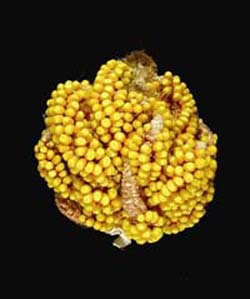The genetic origins of corn on the cob

New gene plays central role in plant architecture and crop domestication
In 1909, while harvesting a typical corn crop (Zea mays) in Illinois, a field worker noticed a plant so unusual that it was initially believed to be a new species. Its “peculiarly shaped ear” was “laid aside as a curiosity” and the specimen was designated Zea ramosa (from the Latin ramosus, “having many branches”). Due to the alteration of a single gene, later named ramosa1, both the ear and the tassel of the plant were more highly branched than usual, leading to loose, crooked kernel rows and to a tassel that was far bushier than the tops of normal corn plants.
Now, researchers at Cold Spring Harbor Laboratory in New York have isolated the ramosa1 gene and shown how it controls the arrangement and length of flower-bearing branches in corn, related cereal crops, and ornamental grasses. The study indicates that during the domestication of corn from its wild ancestor (teosinte), early farmers selected plants with special versions of the ramosa1 gene that suppressed branching in the ear, leading to the straight rows of kernels and the compact ears of modern-day corn on the cob. The findings are described in the July 24 advance online edition of the journal Nature.
“We’ve shown that corn and related grasses have either none, some, or a lot of ramosa1 gene activity, and that these different levels of activity have a big impact on the architecture of the plants,” says Dr. Robert Martienssen of Cold Spring Harbor Laboratory, who led the study. “The ramosa1 gene appears to be a key player in the domestication of corn, and we’ve shown that it acts by signaling cells to form short rather than long branches,” says Martienssen, who was joined in the study by lead author Dr. Erik Vollbrecht, now at Iowa State University.
Says Vollbrecht, “We solved this enduring puzzle by combining classical and modern molecular genetics. The former included our use of transposable elements or ’jumping genes’–discovered at Cold Spring Harbor by [Nobel laureate] Barbara McClintock–to ’tag’ the ramosa1 gene. That enabled us to isolate the gene and determine its DNA sequence for a variety of other experiments.”
“As corn was being domesticated, farmers selected a larger and larger ear with more and more rows of kernels, based on the activity of genes other than ramosa1. But we suspect that as the ear got larger, it needed special alleles of ramosa1 to prevent the extra rows from forming branches instead of kernels,” says Martienssen. “There may have been other reasons for selecting an unbranched ear, including the interaction with other genes that were subsequently lost during domestication, but we don’t yet know if this is the case.”
The study reveals that plants with more ramosa1 activity (e.g. typical corn) tend to have fewer branches, shorter branches, and fewer flowers whereas plants with less ramosa1 activity (e.g. sorghum, rice, and the ramosa corn variety described above) tend to have more branches, longer branches, and more flowers.
“We also looked at a popular ornamental grass that grows outside my office and found the same result. It has a spiky top like corn, so we were delighted to find that they have similar profiles of ramosa1 activity,” says Martienssen.
Media Contact
More Information:
http://www.cshl.eduAll latest news from the category: Life Sciences and Chemistry
Articles and reports from the Life Sciences and chemistry area deal with applied and basic research into modern biology, chemistry and human medicine.
Valuable information can be found on a range of life sciences fields including bacteriology, biochemistry, bionics, bioinformatics, biophysics, biotechnology, genetics, geobotany, human biology, marine biology, microbiology, molecular biology, cellular biology, zoology, bioinorganic chemistry, microchemistry and environmental chemistry.
Newest articles

Properties of new materials for microchips
… can now be measured well. Reseachers of Delft University of Technology demonstrated measuring performance properties of ultrathin silicon membranes. Making ever smaller and more powerful chips requires new ultrathin…

Floating solar’s potential
… to support sustainable development by addressing climate, water, and energy goals holistically. A new study published this week in Nature Energy raises the potential for floating solar photovoltaics (FPV)…

Skyrmions move at record speeds
… a step towards the computing of the future. An international research team led by scientists from the CNRS1 has discovered that the magnetic nanobubbles2 known as skyrmions can be…





















